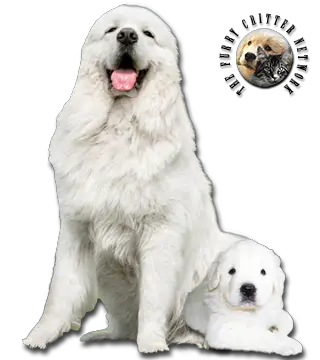Breed Standard
Head: Clean and broad. Marked stop. Large muzzle. Broad forehead. Tight lips.
Ears: Medium size, drop, set on high. Triangular, fairly thick.
Eyes: Medium size, set slightly oblique. Dark brown color. Dark rims
Body: Long, sturdy, and muscular. Pronounced withers. No dewlap. Deep chest. Broad, well-knit loin. Ribs sloping and rather flat. Belly moderately tucked up. Sloping croup. Straight, broad back.
Tail: Set on low. Carried below the topline, curving slightly at the tip. Covered with thick hair forming a flag.
Hair: Short and thick on the head and front of the forelegs. Long, thick, and straight on the neck and body. Thick mane. Heavy undercoat.
Coat: Uniform white. Cream markings are not desirable.
Size: Dog: 65 to 70 cm. (25.6-27.5 in). Bitch: 60 to 65 cm. (23.6-25.6 in).
Weight: 36 to 59 kg. (80-130 lb).
History
The Polish Tatra Sheepdog originated in Podhale, in the Tatra Mountain area of Poland, hence the breed's name. The breed has lived in the Polish mountains for thousands of years, but no exact date for the start of the breed was ever recorded. There is a similar mystery around what breeds were mixed to form the Polish Tatra Sheepdog. While no one is certain, many dog breeders say that the Polish Tatra Sheepdog came from the Mastiff breed. The breed was very popular among mountain workers for several centuries, and up to today. It was so popular because, as its name implies, it was a fantastic sheepdog. This success at herding sheep was mainly due to their high intelligence. When predators were around the sheep, the Polish Tatra Sheepdog would gather up the sheep and stand by them instead of trying to attack the predator, which would leave the sheep open for other attacks. This demonstrates their intelligence. Their white coat also made them easily distinguishable from a bear or wolves, which was very helpful for workers. Also, owners could shave the dogs and use their coat to produce wool. Mountain workers also used to hold their tails while they lead the workers through the mountains and rough terrain. Herding sheep was not the only job the breed could perform. They were often used as personal guards and frequently guarded factories and other private property. On top of this, it was often the case that the breed was used by the police force. The breed faced some hard times, though. After the World Wars the breed was on the brink of extinction. The Federation Cynologique Internationale, (FCI), would not allow this to happen, though, and by the 1960s they started breeding the sheepdog more and more. Centuries ago, as their reputation as excellent sheepdogs spread, the breed spread slowly across Europe, but in 1980, an American Foreign Service Officer enjoyed the breed so much that he had three of them shipped to America, and by 1981 the breed also spread to Canada.
Like other large white European flock guardian dogs such as the Kuvasz, the Pastore Maremmano and the Pyrenean Mountain Dog, the Tatra Shepherd Dog is believed to derive from dogs brought from Asia by nomadic pastoralists.
The first show for these dogs was held in 1937. Because they were in isolated areas of the mountains, a small number of them survived the events of the Second World War. By 1954, when the first post-War show was organised, about 120 examples had been located; once the Zwiazek Kynologiczny w Polsce, the Polish kennel club, was reconstituted after the War, shows were held in Kraków.
The breed was fully recognised by the Federation Cynologique Internationale in 1963 or 1967. It is no longer found only its area of origin, but is distributed through much of Poland; some are in other countries.
The stud-book is open to unregistered dogs judged to be typical of the breed may be added to it. Approximately 300 puppies are born per year, in about 50 litters. Total annual new registrations with the kennel club were 473 in 2011 and 383 in 2012. Not all dogs of this type are registered in the stud-book. Currently, the AKC does not recognize the breed.
Behavior
A lot of today's Polish Tatra Sheepdog's behaviors and qualities can be traced back to its use of guarding. They are territorial, loyal and protective of their owners, and are very good watchdogs for this reason. They have a very loud bark and will bark at anything that is suspicious, as they are trying to protect their family. Since they were trained to be cautious and not attack until completely necessary when predators were around sheep, The Polish Tatra Sheepdog will not bite a stranger or other animals unless continuously provoked, leading them to be considered very dog and animal friendly. From thousands of years of guarding sheep, they are very intelligent, calm and independent.
This dog must not live in an apartment. He needs considerable space and exercise. Weekly brushing is sufficient. During seasonal shedding, stripping the coat is recommended.
Function
Sheepdog, Guard Dog, Pet.






